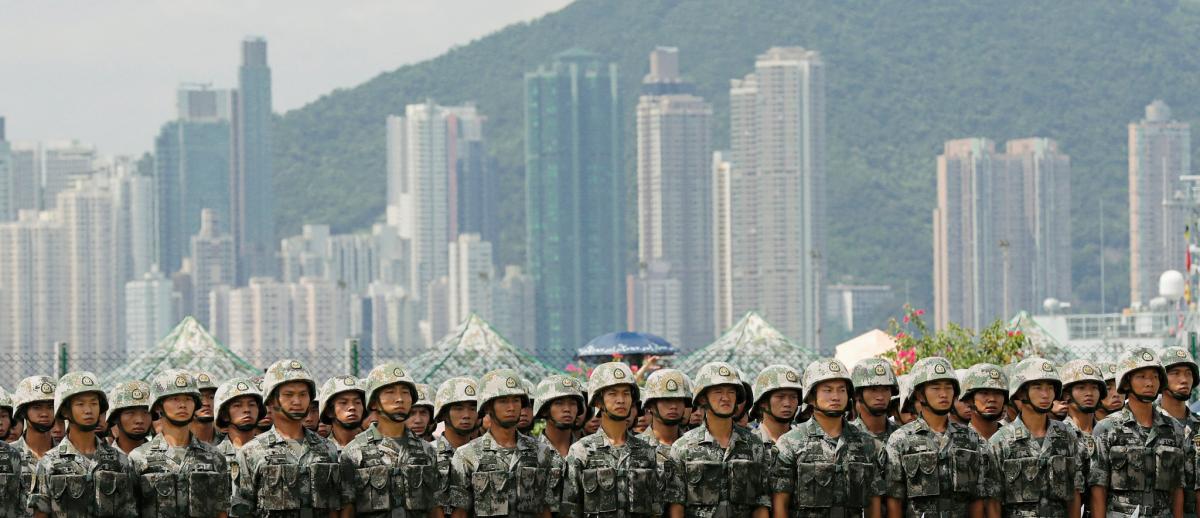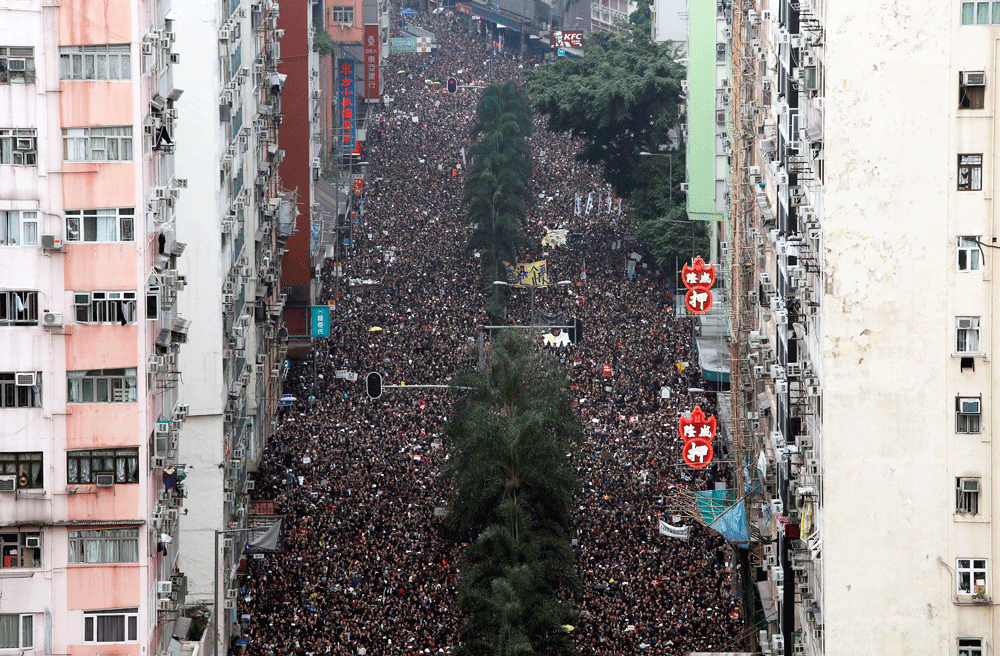The Securitization of Hong Kong Politics: Global Implications
archive


People’s Liberation Army soldiers at Stonecutters Island naval base in Hong Kong, June 2019. (Photo credit: Tyrone Siu/Reuters)
The Securitization of Hong Kong Politics: Global Implications
The recent wave of civil unrest in Hong Kong that commenced in June 2019 needs to be analyzed in light of a host of national security issues raised by the central government in Beijing. These concerns highlight ongoing tensions between the People’s Republic of China and the United States, while at the same time directing attention to continuities between recent unrest and another wave of protests only five years earlier.
On September 26, 2014 Hong Kong Federation of Students1 and members of Scholarism2 commenced a sit-in protest outside the Hong Kong Special Administrative Region (HKSAR) Government headquarters. The protest lasted seventy-nine days and eventually centered in three locations around the city.3 It was unprecedented in its scale and involvement of people from all walks of life. At its peak, the media reported one hundred thousand protesters occupying the principal streets of the city. The local mainstream English-language newspaper South China Morning Post reported every thirty to sixty minutes on major developments of the protest, calling it an “umbrella movement” or even an “umbrella revolution” and dedicating a special section (‘Occupy Central’) on its homepage.4
From civil disobedience to civil unrest
Fast forwarding to 2019, the next wave of social protests was triggered by the Fugitive Offenders Amendment Bill (extradition bill) introduced by the Hong Kong Government. This time the crisis surpasses the worst expectations of some of the biggest pessimists. Unlike the protesters in 2014, this group seemed to be genuinely bottom-up organized. It put forward five demands:
1. complete withdrawal of the extradition bill from the legislative process;
2. retraction of the "riot" characterization that the HKSAR Government initially gave the June 12 gathering of protesters outside the Legislative Council Complex to stall the bill's second reading;
3. release and pardon of arrested protesters;
4. establishment of an independent commission of inquiry into police conduct and use of force during the protests;
5. resignation of Carrie Lam (4th Chief Executive of HKSAR Government) and the implementation of universal suffrage for Legislative Council elections and the election of the Chief Executive.
This time around, the number of participants grew to unprecedented levels—the organizers of the demonstrations claimed that on June 16, 2019 there were around two million citizens on the streets—and the nature of events was akin to guerrilla-type warfare. Metro (MTR) stations were devastated, Hong Kong International Airport was occupied, and major shopping malls were vandalized as were small businesses. The Legco (HK Parliament) was stormed and there was a general strike and sieges of most publicly-funded universities.
Sources of discontent
Commentators typically focus on the political background when trying to account for the current crisis in Hong Kong. Most therefore miss the socio-economic realities that Hong Kong residents have to face daily. Hong Kong is a global city and an international financial center, and like any other global city it magnifies global problems, especially in the socio-economic realm. Due to its limited land supply and to government land policy, it has been one of the most expensive cities on earth, if not the most expensive.5 It also has one of the highest Gini Coefficients for economic inequality,6 and at the same time ranks very high on the Crony Capitalism Index.7 Many feel socially and economically excluded, especially the youth, which translates into political frustration.8
[O]rganizers... claimed that on June 16, 2019 there were around two million citizens on the streets.
It has been around five years since the 2014 events and there is a strong case to be made in terms of continuity between the two waves of protest. The political demands put forward by protesters are, in principle, the same: the introduction of universal suffrage and a genuine representative democratic system. Yet the local government seems unable or unwilling to acknowledge, let alone adequately address, the causes of political discontent. The socio-economic realities continue to worsen for the vast majority of the Hong Kong population and the generational chasm continues to widen, tearing communities and families apart.

Massive protests demanding Hong Kong’s leaders step down and withdraw the extradition bill, June 16, 2019. (Photo credit: Tyrone Siu/Reuters)
What seems to be new however is the level of violence, both that organized and performed by the local government as administered by Hong Kong Police Force (which understandably continues to lose trust and respect among the local population), and the ad hoc violence carried out by local mafia (Hong Kong triads), which seems to play into the hands of the opponents of the political status quo. Importantly, the pressure of the central government in Beijing appears to be heavier than before, with the People's Liberation Army releasing videos of preparations to stifle political resistance in Hong Kong.
The same old and familiar tune of 'national security relevance' can be heard from both the HK and PRC governments. Yet, the Hong Kong people en masse still have not accepted the argument that HK politics should be subject to securitization. The latest wave of public resistance is the best evidence of this rejection.
Securitization of HK issues
The responses of both the Hong Kong SAR government and the central government in Beijing to the 2014 and 2019 events have been less than helpful. In effect, both have continuously tried to frame the major issues concerning public policymaking in Hong Kong as a national security issue. In that sense, Hong Kong politics have effectively fallen victim to the “China Dream” as a litmus test of President Xi Jinping's effectiveness as a state leader.
There are many examples of this phenomenon, but given the brief character of this essay, only two instances will be cited.9 First, Chinese National Security Strategy, adopted by the Politburo of the Communist Party of China on January 23, 2015, is vast enough to include all "unpredictable" and "unprecedented" dangers facing China at home and abroad, and implies further consolidation of power under the unified command of Xi Jinping. According to Chinese media around the same time, National People's Congress deputy Stanley Ng asserted that the mainland's state security legislation should be applied to Hong Kong in the absence of security legislation at the local level.10 Second, the central government in Beijing and its representatives in Hong Kong routinely push for the introduction of a National Security Law (based on article 23 of the Hong Kong Basic Law) in order to "combat radical violence, foreign interference and pro-independence forces in the region."11
Global implications
A representative analysis of the geopolitical context was provided by PRC General Qiao Liang, who back in 2015 was in charge of the education curriculum for officers studying at the prestigious University of Defence (PRC's top military school). Throwing light on the Chinese official understanding of the Hong Kong crisis, he put forward the idea that the United States had created territorial disputes between PRC and Japan, the PRC and the Philippines, and had fomented the Occupy Central crisis itself as part of its response to the rising power of China.12
Hong Kong politics have effectively fallen victim to the “China Dream” as a litmus test of President Xi Jinping's effectiveness as a state leader.
In a similar vein, General Sun Jianguo, the Deputy Chief of the General Staff of the People's Liberation Army, made the following remarks on March 2, 2015 during an interview with Oriental Outlook: "Hostile forces have always attempted to make Hong Kong the bridgehead for subverting and infiltrating mainland China. The illegal Occupy Central activities in 2014 came as minority radical groups in Hong Kong, under the instigation and support of external forces (…) orchestrated a Hong Kong version of a color revolution."13
This narrative is not only still relevant in the Beijing corridors of power but has been arguably strengthened by the recent passing of the so-called Hong Kong democracy bill by the US Congress (H.R.3289 - Hong Kong Human Rights and Democracy Act of 2019).14 Needless to say, the ongoing 'trade war' between the two global economies further focuses the attention of American and Chinese policymakers as well as respective national intelligence agencies on the future prospects of Hong Kong. This attention is not welcomed by business circles in the city, who now fear that the US State Department may not recommend to the US Congress to uphold Hong Kong’s “special status” (which is revised yearly based on the United States-Hong Kong Policy Act of 1992).15 This has to be analyzed against the backdrop of the global pandemic of COVID 19, which has already caused a formidable loss of life and economic destruction all around the world, the consequences of which we are more than likely to suffer from for years to come.
The HK pro-democracy camp, on the other hand, openly calls for the Western world (the UK and US in particular) to staunchly oppose Beijing on any front in order to preserve the unique character of the city, at least until the final handover scheduled for 2047. In that respect, HK deserves the continued close attention of the international community as it is likely to serve as a litmus test of sorts. The coming years and the evolving political situation in the city will reflect the condition of the global economy as well as the state of the worldwide competition between the US and the PRC.
1. As of June 2020 The Hong Kong Federation of Students is formed by the student unions of 4 institutions: Chinese University Students’ Union, Lingnan University Students’ Union, Hong Kong Shue Yan University Students’ Union and Hong Kong University of Science and Technology Students’ Union. Recently Hong Kong Polytechnic University, Hong Kong Baptist University and City University Students’ Unions left the Federation due to internal conflicts over the participation in the Umbrella Movement 2014. See more at: http://www.hkfs.org.hk/ accessed 17 April 2020.
2. Originally formed as “Scholarism – The Alliance Against Moral & National Education”, Scholarism was the first student pressure group to protest against the pro-Communist “Moral and National Education” school curriculum put forward by the Hong Kong Government in 2012. See more at: https://en.wikipedia.org/wiki/Scholarism (unfortunately, no other link in English is available) accessed 17 April 2020.
3. After initially focusing on the HKSAR Government headquarters site in Admiralty, more and more protesters decided to join in Central and Causeway Bay of HK Island. Kowloon peninsula also had its share with protesters occupying streets in the commercial areas of Mong Kok.
4. See more at: https://www.scmp.com/topics/occupy-central accessed 17 April 2020.
5. See more at: https://www.cnbc.com/2019/03/19/paris-singapore-hong-kong-named-worlds-most-expensive-cities.html accessed 17 April 2020.
6. See more at: https://www.hkeconomy.gov.hk/en/pdf/wp/gini_comparison.pdf accessed 17 April 2020.
7. See more at: https://www.scmp.com/business/article/1967952/hong-kong-king-crony-capitalism-and-should-be-worry-competition-commission accessed 17 April 2020.
8. On long term consequences of Economic and political exclusion see: Daron Acemoglu and James A. Robinson, “Why Nations Fail. The Origins of Power. Prosperity, and Poverty, 2012, Crown Publishers: New York.
9. For an in-depth analysis of the discussed problem please see the author’s original paper at: http://gis.hkbu.edu.hk/files/POLITIKA_Annual%20Journal%20Session%202018-2019.pdf
10. S. Tiezzi, China’s National Security Strategy, “The Diplomat”, 24 January 2015, http://thediplomat.com/2015/01/chinas-national-security-strategy/ accessed 17 April 2020.
11. See more at: https://amp.theguardian.com/world/2020/apr/15/china-official-hong-kong-luo-huining-pushes-national-security-law?hl=en-US&gl=US&ceid=US%3Aen&__twitter_impression=true accessed 17 April 2020.
12. Q. Liang, One belt, one road, heartland. “Eurasian Review of Geopolitics”, http://temi.repubblica.it/limes-heartland/one-belt-one-road/2070 accessed 17 April 2020.
13. Oriental Outlook is a weekly news magazine affiliated with Xinhua. See more at: https://www.scmp.com/news/hong-kong/article/1728027/hong-kongs-occupy-protest-was-attempt-colour-revolution-pla-general accessed 20 April 2020.
14. See more at: https://www.congress.gov/bill/116th-congress/house-bill/3289 accessed 17 April 2020.
15. See more at: https://uscode.house.gov/view.xhtml?path=/prelim@title22/chapter66&edition=prelim accessed 17 April 2020.



